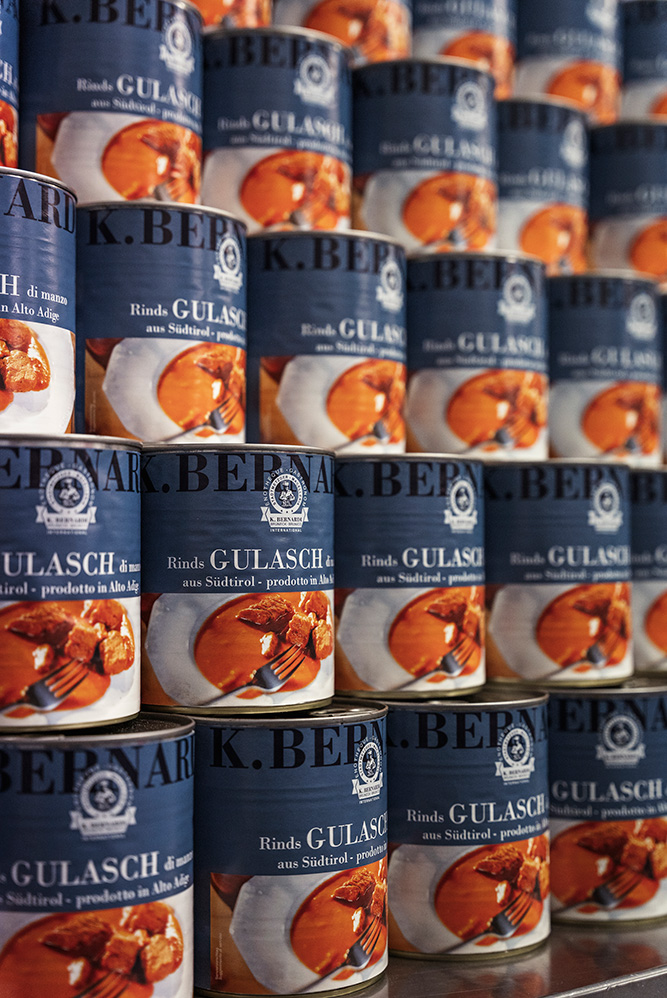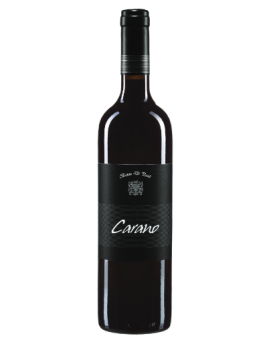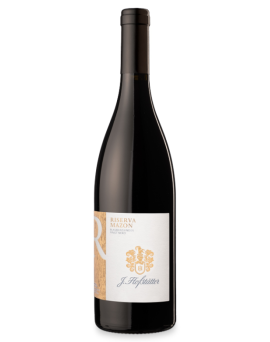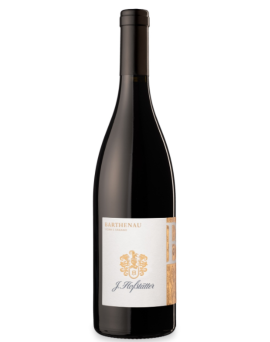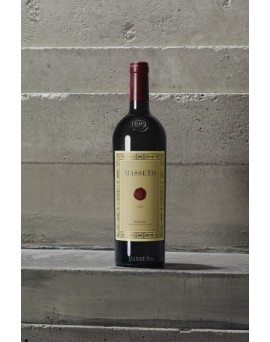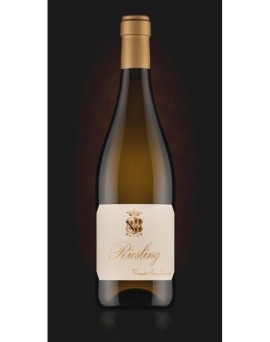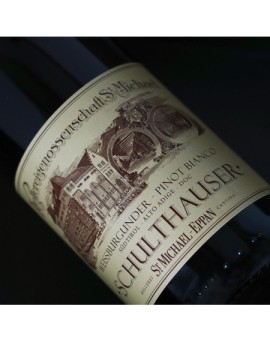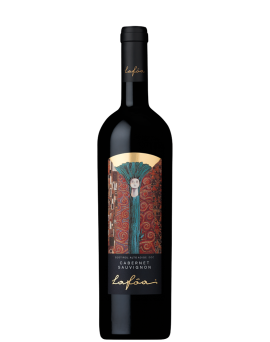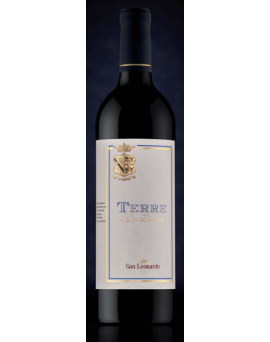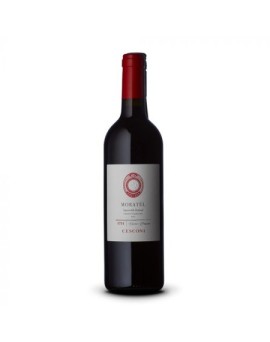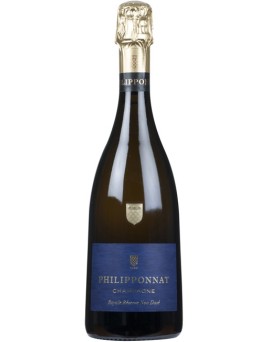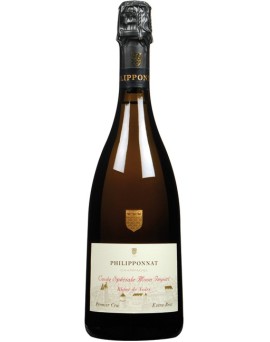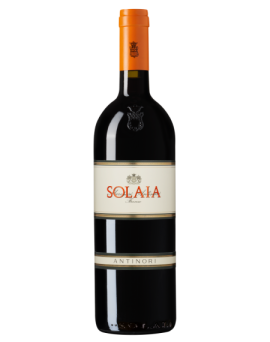Basket
0
Active filters
Pinot Noir 2019 Riserva...
RISERVA MAZON PINOT NOIR<br /><br />Its colour is a deep ruby-garnet red, the bouquet reveals the typical notes of undergrowth, berries and sour cherries - ripe, sweet and seductive. On the tongue, it develops<br />warm, harmonious, round and multi-faceted. A great wine of international standard with an expressive body, which can develop its great potential even better after another 2<br />years of bottle ageing.<br /><br />Pinot Noir was first successfully cultivated in South Tyrol at the beginning of the 19th century. It soon became apparent that the gentle hills and the special microclimate of<br />the high plateau in Mazon offered the ideal conditions for producing Pinot Noir of international calibre.<br />Riserva Mazon<br />Hofstätter Classification<br /><br />Grape variety<br /><br />Pinot Noir<br />Soil<br /><br />Conglomerate of clay, limestone and porphyry soils.<br />Vinification<br /><br />75% of the grapes are destemmed, 25% enter the fermentation tank intact. Fermentation lasts about 10 days, during which time the must is kept in constant contact with<br />the grape skins.<br />Maturity<br /><br />The Riserva is aged for one year in small wooden barrels, after the assemblage for another six months in large wooden barrels and then for another year in the bottle.<br />Serving temperature<br /><br />14° - 18° C<br />Recommended food<br /><br />Red meats, lamb, poultry and game.<br />
Price
€42.30
Blauburgunder 2017...
BARTHENAU<br />VIGNA S. URBANO PINOT NOIR<br /><br />A Pinot Noir whose dark ruby-red colour already hints at its enormous concentration.<br />If the nose is still somewhat closed at first, it soon releases its aromas in the glass, which are reminiscent of the multi-faceted bouquet of classic Burgundies.<br />The enveloping scent of sour cherries and raspberries is underlined by delicate vanilla tones and fine spicy notes.<br />On the palate, it is very well balanced and convinces with its elegant acidity, well-integrated tannins and an impressively aromatic concentration.<br /><br />The Barthenau Vigna S. Urbano is an expression of our most valuable Cru site. It is located in the heart of the vineyards around our estate Barthenau near Mazon.<br />This Pinot Noir reflects the enormous potential of this unique site, where vines grow, some of which are more than 55 years old.<br /><br />Only the classification 'Vigna' guarantees the origin of a site wine in South Tyrol.<br />VSU<br />Hofstätter Classification<br /><br />Grape variety<br /><br />Pinot Noir<br />Soil<br /><br />Conglomerate of clay, limestone and porphyry soils.<br />Vinification<br /><br />After delivery, the majority of the grapes are lightly crushed and destemmed, 25% enter the fermentation barrel intact. After a short, cool maceration to refine the fruit<br />bouquet, the wine ferments for about 10 days. During fermentation, the must is kept in constant contact with the solid grape components.<br />Maturation<br /><br />The ageing in wooden barrels takes place in two different phases: in the first phase, the wine is aged for about 12 months in small oak barrels; in the second phase, after the<br />assemblage, it is aged for about another 8 months in large oak barrels. After bottling, the wine is stored for another 8 months in the cellars of Ansitz Barthenau.<br />Food recommendation<br /><br />Red meats, game, mild cheeses.<br />
Price
€73.00
Masseto 2016 IGT Ornellaia...
2016<br />As is often the case in recent years, the winter of 2016 was characterised by unusually warm weather with heavy rainfall in February. Budding arrived on time in the last<br />week of March. The abundance of water in the soil and the warm weather in April favoured rapid and normal vegetative growth of the vines. In May, temperatures returned to<br />normal, slowing growth slightly and leading to flowering in the last week of May in dry, sunny weather, perfect for good fruit set. Summer temperatures were normal with very<br />little rain causing considerable water stress towards the end of the ripening phase. The usual mid-August storms were also absent, prolonging the water stress throughout<br />the early part of the harvest. Fortunately, the remarkably cool temperatures during the night allowed the vines to recover from the heat of the day. Maturation proceeded<br />smoothly with excellent phenolic potential and a balanced sugar/acid ratio. The harvest began on 24 August with the youngest vines. In September, the few rainfalls provided<br />the soil with sufficient water to complete the harvest in practically perfect conditions. The older vines of the 'Masseto centrale' benefited from this situation, continuing their<br />ripening until the third week of September. The last plots were harvested on 20 September.<br />TASTING NOTES: 2016 was a textbook year for Masseto, with a typically Tuscan coastal climate that saw a dry and sunny growing season, with plenty of sunshine and<br />just the right amount of rain for perfect ripeness. The 2016 has a particularly intense young colour, and on the nose the intense aroma of ripe dark fruit blends with subtle<br />notes of cocoa and spices. On the palate, the rich, dense structure of ripe, silky tannins is balanced by a sensual, vibrant fruit note and lively acidity that keeps the long<br />finish clean and full-bodied.<br />
Price
€1,480.00
Riesling 2015 SAN LEONARDO...
Comments | With its classic varietal structure, fine acidity, and pronounced minerality, this Riesling offers true elegance and appealing, multi-layered complexity.Grape<br />varieties | 100% RieslingFermentation | 12 hours of low-temperature maceration on the skins, followed by gentle pressing and fermentation for 20/25 days.Maturation | 12<br />months sur lie in new and once-used large French oak casks Cellarability | 10 years and more.<br />
Price
€34.40
Pino Bianco Schulthauser...
South Tyrolean Pinot Blanc<br />Schulthauser 2020<br /><br />Pinot Blanc, South Tyrol's most important grape variety, has awoken from its slumber and has become the region's flagship wine. Schulthauser is the classic among South<br />Tyrolean Pinot Blancs; it was first vinified and bottled in 1982. It is not a loud drop, but a consummate, finely fruity-fresh Pinot Blanc, which at the same time seduces with<br />creamy softness and racy acidity to enjoy.<br /><br />Grape variety: Pinot Blanc<br />Vine age: 10 to 40 years<br />Growing region: Site: Vineyards in 'Schulthaus' above Schloss Moos in Eppan/<br />Berg (540-620m)<br />Exposure: Southeast<br />Soils: Calcareous gravel soils with loam<br />Method of cultivation: Guyot<br />Harvest: Mid to late September, harvest and grape selection by hand.<br />Vinification: The majority (85%) is fermented in steel tanks, the rest in wooden barrels followed by<br />followed by biological acid reduction. In February the two<br />wines are blended.<br />Yield: 60 hl/ha<br /><br />Analytical data:<br />Alcohol content: 13.5<br />Acidity: 5,7 gr/lt<br />Drinking temperature: 8-10°.<br /><br />Recommendation: Exclusive aperitif and summer wine, but also a versatile food companion: it tastes good with seafood and fish, as well as with delicate dishes of wild fowl.<br />It is particularly recommended with South Tyrolean Schlutzkrapfen.<br /><br />Ageing/potential: 4 to 5 years<br /><br />Awards:<br />2019: 93 points Luca Maroni, 92 points James Suckling, 91 points Robert<br />Parker, 91 points Falstaff, 90 points I Vini di Veronelli, 90 points Intravino.<br />2018: 94 points Wine Enthusiast, 91 points James Suckling, 91 points<br />Decanter<br />2015: 89 points Wine Spectator<br />2012: 90 points Wine Spectator; 90 points Wine Enthusiast<br />
Price
€8.50
Cabernet Sauv. LA FOA 2018...
Description<br /><br />Very deep violet/black colour. Highly dense bouquet, chassis, blackberries. Very powerful yet elegant attack, densely concentrated tannins on the palate, powerful<br />backbone and enormously long finish.<br /><br />High ageing potential: 10-15 years.<br /><br />Recommended food: Goes well with strong dishes with red meat, grilled or roasted, but especially with game and with spicy cheeses.<br />Serving temperature: 16° C.<br />Grape variety: Cabernet Sauvignon.<br />Sites: The vineyard site is located at an altitude of 430 m above sea level with optimal sun exposure. A rather dry site, with sandy, gravelly moraine soil.<br />Vinification: Maceration for 10 days with gentle circulation of the marc followed by maceration for a further 10-14 days. Racking of the young wine into new/used barriques,<br />malolactic fermentation, several transfers of the wine during the 18 months of ageing. Gentle coarse filtration before bottling.<br />Analytical values:<br />Alcohol: 13.5% vol.<br />Total acidity: 5,1 g/l<br />Sugar-free extract: 31,2 g/l<br />Residual sugar: 1,6 g/l<br />
Price
€87.40
Terre di San Leonardo 2018...
Comment: Terre, a classic Bordeaux blend, follows in the footsteps of its 'big brother' San Leonardo, born of the same terroire, expressing great freshness and balance.<br />Grape varieties: 50% Cabernet Sauvignon, 40% Merlot, 10% Carmenère.<br />Vinification: Spontaneous fermentation in small cement vats for about 15/18 days with several daily pump-overs and délestage.<br />Maturation: 80% in cement vats and 20% in French oak barriques.<br />Ageing time: 5 years and more.<br />
Price
€15.00
Moratel CESCONI Biologico...
Moratel is a blend of four red grapes that we grow in two very distinct areas, both in terms of soil and climate. Lagrein is located in Pressano, while Teroldego, Merlot and<br />Cabernet grow in the vineyards in Valle dei Laghi.<br /><br />PRODUCTION AREA<br />The Lagrein vineyard is cultivated with a pergola system with a western exposure. It is the same vineyard that produces the grapes for our Pletter reserve, but in this case<br />the<br />However, in this case the vines are younger, with an average age of about 20 years. The climate is continental and the soil is composed of a sedimentary rock type<br />consisting of limestone and compact sandstone known as the Werfen strata. The Valle dei Laghi, on the other hand, has a Mediterranean climate and from here, with vines<br />trained using the guyot system, we harvest Teroldego,<br />Merlot and Cabernet. The soils are of morainic origin and in the case of Merlot, which grows in the Pivier vineyard, there is a substantial amount of clay and silt.<br /><br />WINEMAKING<br />The hand-picked grapes are destemmed and the grapes, left whole, ferment in stainless steel tanks. Maceration lasts about 10 days for Lagrein and Teroldego and about<br />20 days for Merlot and Cabernet. Once fermentation is complete, the wine is aged in barriques for about 12 months and only then is the cuvée between the different wines<br />made. In order to<br />In order to safeguard the freshness and fruity characteristics of the wine, the barrels used are exclusively used. After bottling, Moratel is left to mature for at least six<br />months in the bottle before release.<br /><br />VINEYARDS OF THE DOLOMITES IGT<br /><br />Grapes: Lagrein, Teroldego, Merlot, Cabernet<br />Vineyards: Pressano and Valle dei Laghi<br />Soil: In Pressano, soils consisting of limestone and compacted<br />in Pressano; in Valle dei Laghi of morainic origin.<br />Vinification: fermentation in stainless steel tanks and ageing in used barriques<br />
Price
€16.20
Champagne Non Dosé...
Royale Réserve Non Dosé<br /><br />65% Pinot Noir, 30% Chardonnay and 5% Pinot Meunier. 20-30% reserve wines, managed in 'Solera'. No dosage in order not to mask the character and purity of the wine.<br />Over three years of ageing on the lees at a constant temperature of 12°C. It expresses the quality of Philipponnat's non-vintage blends. Colour: pale gold. Fine and persistent<br />mousse. On the nose: lime blossom, vine flower and hawthorn. On the palate: citrus notes and a nice liveliness without being aggressive. The finish is long and clear, with<br />notes of warm bread and fresh apple.<br />
Price
€62.40
Champagne Blanc de Noirs...
Blanc de Blancs - Premier Cru - Extra Brut<br /><br />100% first-pressing Chardonnay, partially vinified in wood, it remains in contact with the yeasts for more than 4 years developing fine and numerous bubbles. Generous, fine<br />and at the same time delicate with a good dose of minerality when young, which tends to become complex and broad as the years go by, after dégorgement.<br />
Price
€86.60
Solaia 2018 IGT Toscana...
Solaia Toscana IGT 2018<br /><br />Climate: The 2018 season in Chianti Classico opened with a rather regular winter in terms of both temperatures and rainfall; despite these climatic conditions, the vineyards<br />began their budding activity a week earlier than the historical average for the area. The spring period, and in particular May, was characterised by frequent rainfall and slightly<br />lower than usual temperatures, while June and July were dry and fairly warm, without ever experiencing extreme conditions. A few rainfalls in August and a dry and windy<br />period in September and October allowed the grapes to ripen in an ideal manner, guaranteeing a good sugar content and excellent polyphenolic ripening. The harvest began<br />in the last days of September with the Cabernet Franc, continued with the Sangiovese and concluded with the Cabernet Sauvignon on 10 October.<br /><br />Total annual rainfall: 845.9 mm<br /><br />Average temperature 1 April - 12 October: 20.4 °C<br /><br />Rainfall 1 April - 12 October: 286 mm<br /><br />Vinification: Great care was taken, both in the vineyard during harvest and in the cellar, where the grapes were destemmed and the berries, carefully selected at the sorting<br />table, were transferred after pressing by gravity into the tanks. It is essential that only the perfect grapes reach the 60 hl truncated cone vinification tanks. During<br />fermentation and maceration, great care was taken to maintain the correct balance between the fruit and the quality of the tannins in order to express to the full the<br />sweetness, fragrance, identity and character of Solaia. Immediately after racking, malolactic fermentation began in barriques, enhancing the complexity and pleasantness of<br />the wine. The ageing process took place in new French oak barrels for about 18 months. After an initial period in separate lots, these were blended to complete the<br />maturation in wood.<br />Historical data<br /><br />Solaia is a vineyard of about 20 hectares (12 acres) facing southwest between 350 and 400 meters (1,500 and 1,300 feet) above sea level on a rocky limestone soil with<br />alberese and galestro rocks, located at Tenuta Tignanello. The Antinori family produced this wine for the first time with the 1978 vintage; the initial blend was 80% Cabernet<br />Sauvignon and 20% Cabernet Franc, which was repeated in 1979. In subsequent vintages, 20% Sangiovese was introduced, and some corrections were made to the ratio of<br />Cabernet Sauvignon to Cabernet Franc, leading to the current composition. Solaia is produced only in exceptional vintages and was not made in 1980, 1981, 1983, 1984 and<br />1992.<br /><br />Tasting notes: Solaia 2018 has an intense ruby red colour. On the nose the intense notes of ripe dark fruit, in particular blueberry and blackcurrant, combine with pleasant<br />hints of dried flowers and lavender, accompanied by delicate spicy sensations of white pepper and balsamic hints of mint and eucalyptus. Sweet and well-integrated aromas<br />of white chocolate, candyfloss and dried fruit complete the rich bouquet. On the palate it is enveloping and creamy: the tannins, soft and silky, give a long, persistent and<br />very elegant finish, with an aftertaste reminiscent of liquorice and recalling the floral and spicy notes perceived on the nose.<br />
Price
€451.40

